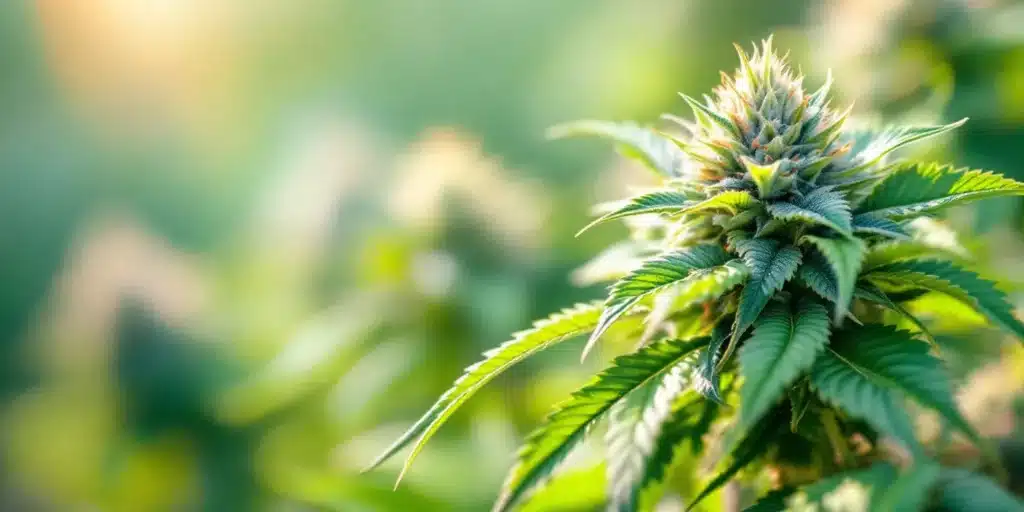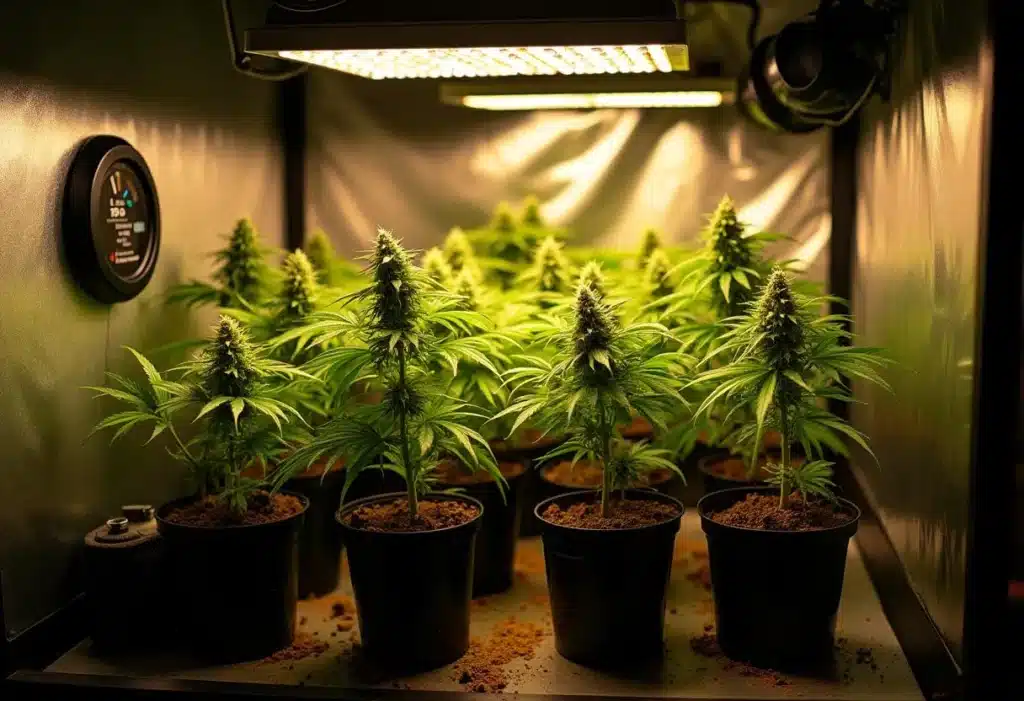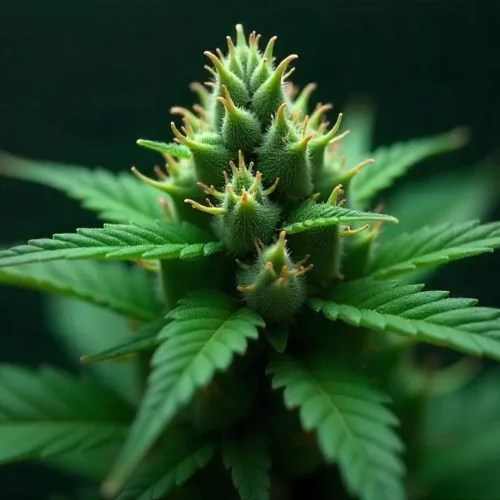Identifying and Choosing Female Cannabis Clones
Why Female Clones Are Essential for Quality Yield
Female clones are critical for maximizing both yield and quality. Unlike male plants, female cannabis plants produce the cannabinoid-rich buds that growers and consumers seek. Cloning from female plants ensures that every plant in your garden can deliver potent flowers, increasing your overall yield and return on investment.
By starting with female clones, you eliminate the risk of male plants, which can disrupt a grow room by producing seeds and lowering potency. Every female clone you cultivate can contribute to a high-quality, cannabinoid-rich harvest.
Recommended Strains
Recognizing Female Plants in the Cloning Process
Knowing when a plant is ready for cloning improves the success rate of your clones. Look for female plants that display clear preflowers, small, hair-like pistils at the nodes that indicate a female plant. These early indicators are crucial when choosing clones, as they provide assurance that the plants will produce the desired buds instead of pollen.
Understanding how to spot these signs ensures a high success rate in producing female clones, leading to consistent and reliable harvests.
Benefits of Using Female Clones Over Seeds
Choosing female clones over seeds offers multiple benefits for growers. Female clones allow you to skip the uncertainty of plant sex, saving time and resources in the cultivation process. You won’t have to wait through the early growth stages to identify female plants; you’ll start with a guaranteed producer from day one.
Additionally, female clones reduce genetic variability. Each clone retains the characteristics of its mother, allowing for consistent potency, effects, and cannabinoid profiles across your crop. For anyone looking to replicate a strain’s specific qualities, female clones are the best option.
Promos & Deals
Ensuring Consistency with Female Cloning
Key Characteristics of a Reliable Female Clone
A reliable female clone originates from a mother plant with proven genetics and high-quality traits. Look for mother plants that are vigorous, pest-resistant, and free from nutrient deficiencies or stress. The stronger the mother plant, the more resilient the clone will be.
Consistency starts with the selection process. Clones taken from mothers displaying high resin production, dense buds, and strong stems will replicate those qualities, giving you a predictable and productive crop.
Avoiding Hermaphrodites and Male Plants in Cloning
Hermaphrodite plants can negatively impact a grow, producing seeds instead of high-quality buds. Avoid this risk by inspecting plants carefully and selecting only those with clear female characteristics. Even a small number of male traits in a plant can introduce unwanted pollen to your crop, so it’s vital to be vigilant.
To ensure purity, inspect your plants frequently, particularly if they’ve been stressed. Stress can sometimes trigger hermaphroditism, which is preventable by keeping a stable, low-stress environment for your clones.
Selecting the Healthiest Mother Plants for Cloning
The mother plant is the foundation of your clone’s success. Choose mothers that exhibit strong growth, pest resistance, and high cannabinoid profiles. A well-chosen mother will produce clones that inherit her strength and quality, setting you up for a robust grow cycle.
Healthy mother plants typically have vibrant foliage, robust stems, and show no signs of nutrient deficiencies or stress. By selecting mothers with desirable traits, you’ll ensure that every clone starts strong and grows to its full potential.

Optimizing the Growth of Female Cannabis Clones
Nutrients and Light Requirements for Female Clones
Female clones need a nutrient balance that supports root development and early growth. A balanced solution with low nitrogen encourages root formation, especially in the initial stages. As clones mature, gradually increase nutrient levels to support vegetative growth.
Light is another key factor. Female clones benefit from an 18/6 light cycle (18 hours of light, 6 hours of darkness) to promote steady growth. LED lights are highly effective, as they allow you to control spectrum and intensity based on the specific needs of your clones.
Managing the Environment for Female Clone Success
Female clones thrive in a controlled environment. Aim for temperatures between 70-75°F and maintain humidity levels around 70% to boost root formation. High humidity helps retain moisture in the leaves, allowing clones to focus their energy on rooting rather than water absorption.
Keeping a consistent environment minimizes stress and encourages healthy root development, giving clones a head start before transitioning to vegetative growth.
Monitoring and Adjusting for Maximum Potency and Yield
Regular monitoring is essential to maximizing the potential of female clones. Check clones frequently for signs of stress, nutrient deficiencies, or environmental changes. Light and humidity adjustments may be necessary as clones grow, ensuring they remain healthy and on track to reach their full potency and yield.
With consistent attention to these factors, you can create the ideal conditions for female clones to flourish, enhancing the quality of your final harvest.

Techniques to Maximize Female Clone Success
Best Practices for Taking Cuttings from Female Plants
When taking cuttings from a female plant, timing and technique matter. Choose branches that are 4–6 inches long, preferably with at least two nodes. Make a clean 45-degree cut just below a node, which promotes better root development. Using sterile tools is crucial here to prevent infections and ensure that the cuttings root effectively.
For optimal results, take cuttings in the early morning or evening when plants are naturally retaining more moisture. This small timing adjustment improves the chances of a healthy clone, increasing both rooting speed and overall success rates.
Using Rooting Hormones for Faster Clone Development
Rooting hormones are a powerful tool for speeding up clone development. These hormones stimulate faster root growth, helping clones establish themselves more quickly. Apply a small amount of rooting hormone to the cut end before placing it in your growth medium. Rooting gels are popular for their easy application and effectiveness in creating robust root systems.
Consistency is key when applying hormones. Only a thin layer is necessary, as too much can hinder growth. By using rooting hormones correctly, you encourage clones to thrive early on, setting the stage for a healthy and productive crop.
Maintaining Humidity Levels to Enhance Root Growth
High humidity is essential for rooting female clones, as it prevents the leaves from drying out while roots are still developing. Use a humidity dome or mist the clones daily to maintain humidity levels around 70–80% during the initial stages. Consistent moisture keeps leaves hydrated, allowing clones to focus on root formation.
Over time, as roots establish, gradually reduce humidity to encourage acclimation. Lowering humidity in stages helps clones adapt to normal growing conditions without experiencing stress, leading to stronger, healthier plants.
Troubleshooting Common Issues with Female Clones
Recognizing Stress Symptoms in Female Clones
Female clones show distinct signs when stressed, including wilting, yellowing leaves, and slowed growth. These symptoms often result from inconsistent humidity, incorrect lighting, or improper nutrient levels. Early identification and intervention are crucial; addressing issues at the first sign of stress ensures the clone stays on track.
Regular monitoring helps you spot potential problems quickly, enabling you to adjust conditions immediately. By keeping an eye on your clones’ appearance, you can act swiftly to maintain their health and productivity.
Dealing with Nutrient Deficiencies in Clones
Nutrient deficiencies are a common challenge in clone development. Yellowing leaves often indicate nitrogen deficiency, while purple stems suggest phosphorus shortages. Keep nutrients balanced and light at the start to avoid overwhelming delicate root systems. A gentle nutrient mix with slightly reduced nitrogen levels promotes root growth over leaf production.
As clones mature, adjust the nutrient balance to meet their developing needs. Monitoring and fine-tuning nutrients can greatly impact the overall strength and yield of your female clones.
Preventing Pest and Disease in Early Cloning Stages
Female clones are susceptible to pests and disease, especially during the delicate rooting phase. Regularly inspect clones and keep the environment clean to avoid common issues like mildew, aphids, and spider mites. Applying a mild pest prevention solution at the early stages can protect against infestations that could stunt growth.
Ensuring proper airflow around clones can also reduce mold and mildew risks, creating an environment where female clones can thrive without unwanted intruders. Prevention is always more effective than treatment, so maintain a proactive approach to pest and disease control.
Enhancing the Genetic Stability of Female Clones
Selecting Clones with Consistent Genetic Traits
Not all female clones are created equal; selecting clones from a stable genetic lineage helps maintain consistency in your crop. By choosing mother plants with reliable characteristics, such as potency, yield, and resistance to pests, you can propagate clones that reliably carry those same traits.
Clones from genetically stable mothers produce uniform plants, making it easier to predict harvests. For cultivators focused on quality and reliability, selecting stable female clones is a foundational step toward a consistent growing experience.

Propagating Clones from Robust Mother Plants
Robust mother plants pass on resilience and strength to their clones. Choose mother plants that have demonstrated strong growth, pest resistance, and high yields to ensure these traits carry over to each clone. Healthy, robust mothers serve as the genetic base for a successful crop, giving clones the best chance at thriving.
To maintain these traits, avoid stressing the mother plant before taking cuttings. A well-cared-for mother plant leads to healthy clones, which translates to healthier yields and consistent quality.
Long-Term Benefits of Genetic Consistency in Cloning
Genetic consistency across female clones brings stability and predictability to your growing operations. With consistent clones, you know exactly what to expect in terms of growth rates, flowering times, and cannabinoid profiles. This stability benefits both personal growers and commercial cultivators by reducing the variables that can impact crop quality.
Over time, using genetically consistent clones helps you refine your growing practices, creating an environment tailored to maximize your specific strain’s potential. The result is a well-established cycle that produces high-quality yields with each new clone generation.
Preparing Female Clones for Transplant
When to Transition Clones from Rooting to Vegetative Stage
Timing is key when moving female clones from rooting to the vegetative stage. Most clones are ready once they show several strong roots, usually within 1–2 weeks of taking cuttings. At this stage, they can handle an increase in nutrients and lighting, which encourages growth beyond rooting.
Transitioning too early can shock the clone, while waiting too long may cause stagnation. By monitoring root development closely, you’ll know exactly when each clone is prepared for the next growth phase.
Hardening Off Clones for Outdoor or Indoor Growing
Whether planting clones indoors or outdoors, hardening off helps prepare them for their new environment. Start by gradually reducing humidity levels and introducing them to natural light if transitioning outdoors. This process lets clones adjust to temperature variations and light intensity, reducing the risk of transplant shock.
For indoor grows, hardening off involves adjusting lighting intensity and airflow. With proper preparation, your clones will adapt more readily to their new setting, growing with vigor and resilience.
Techniques for a Smooth Transplant to Avoid Shock
Transplant shock is a common issue when moving clones. To avoid it, water clones thoroughly before transplanting, which keeps the roots hydrated and prevents drying. Be gentle with root handling and ensure the new growing medium is moist but not waterlogged.
Once transplanted, give clones a few days to adapt before increasing light intensity or adding nutrients. This gradual approach reduces stress, ensuring your female clones settle comfortably into their new environment.
Advanced Methods for Cloning Female Cannabis Plants
Tissue Culture Cloning for Superior Genetic Preservation
Tissue culture cloning is an advanced method that preserves the exact genetic material of your female cannabis plants. Through this technique, you can maintain a plant’s unique traits over many generations, reducing genetic drift that can occur with traditional cloning methods. Tissue culture is ideal for preserving rare or high-quality strains, allowing growers to maintain the plant’s specific cannabinoid and terpene profiles indefinitely.
While more complex than traditional cloning, tissue culture provides a higher level of genetic security, ensuring that each clone is a true copy of the original plant. For growers who prioritize genetic purity, tissue culture cloning is worth exploring.
Cloning from Flowering Plants: Pros and Cons
Cloning from flowering plants, often called “monster cropping,” can be a viable option for preserving desirable traits even if a plant is already in bloom. This technique involves taking clones from flowering plants, resulting in bushier clones that may yield more buds. However, clones from flowering plants may take longer to root and re-enter the vegetative stage.
While monster cropping can provide a fuller, more robust plant, it requires extra time and care. For growers seeking to maximize yield, this approach can be beneficial, but it’s essential to weigh the time and effort required.
Tips for Cloning Rare and High-Quality Female Strains
Preserving high-quality or rare female strains requires careful cloning and attention to detail. Start by selecting the healthiest cuttings and use rooting hormones to increase the success rate. These rare clones deserve extra care, so maintain an optimal environment with stable temperatures, humidity, and light.
Using advanced cloning techniques, such as tissue culture or monster cropping, helps maintain the distinct qualities of these unique strains. With dedicated care, you can keep rare strains alive and thriving, bringing the best of your collection into every harvest.
Frequently Asked Questions on Female Clones
How Long Does It Take for Female Clones to Root?
Female clones typically take about 1 to 2 weeks to form roots. However, rooting time can vary depending on factors like humidity, temperature, and nutrient availability. Providing consistent light, optimal humidity, and maintaining a stable temperature speeds up the rooting process and encourages stronger, healthier roots.
What’s the Best Light Schedule for Female Clones?
For female clones, an 18/6 light schedule (18 hours of light and 6 hours of darkness) is usually recommended to promote strong root development and maintain them in the vegetative stage. This schedule prevents early flowering and gives clones the energy they need to grow. Some growers prefer a 24-hour light cycle initially to stimulate faster rooting, but an 18/6 cycle balances growth with energy efficiency.
How Can I Tell If a Clone Is Female?
A female cannabis plant typically has pistils, small, hair-like structures, near the nodes, while male plants develop pollen sacs. When cloning, it’s best to select from plants that have shown clear female characteristics to ensure each clone will produce buds. Regular monitoring of mother plants helps identify these characteristics, allowing you to choose the best candidates for cloning.
Do Female Clones Produce the Same Yield as the Mother Plant?
Yes, female clones should produce a similar yield to the mother plant, assuming optimal growing conditions and no major stressors. Clones carry the same genetic profile as their mothers, meaning they inherit the potential for comparable yield and potency. Ensuring consistent care and conditions will help clones reach the same performance level as the original plant.
Can I Clone Female Plants Multiple Times?
Absolutely! Female plants can be cloned multiple times, and the clones can also be cloned, leading to several “generations” of the same genetic profile. However, cloning from clones repeatedly may eventually cause slight genetic drift, which could affect plant characteristics over time. For best results, many growers prefer to clone directly from the original mother plant or maintain a “mother room” with selected plants for long-term cloning.
How Can I Avoid Stress When Transplanting Female Clones?
To avoid transplant shock, give clones adequate water before moving them, and ensure the new growing medium is pre-moistened. Handle roots carefully, and allow the clones a few days to adapt before exposing them to intense light or increased nutrients. Gradual acclimatization keeps plants stress-free, helping them settle into their new environment more smoothly.


















